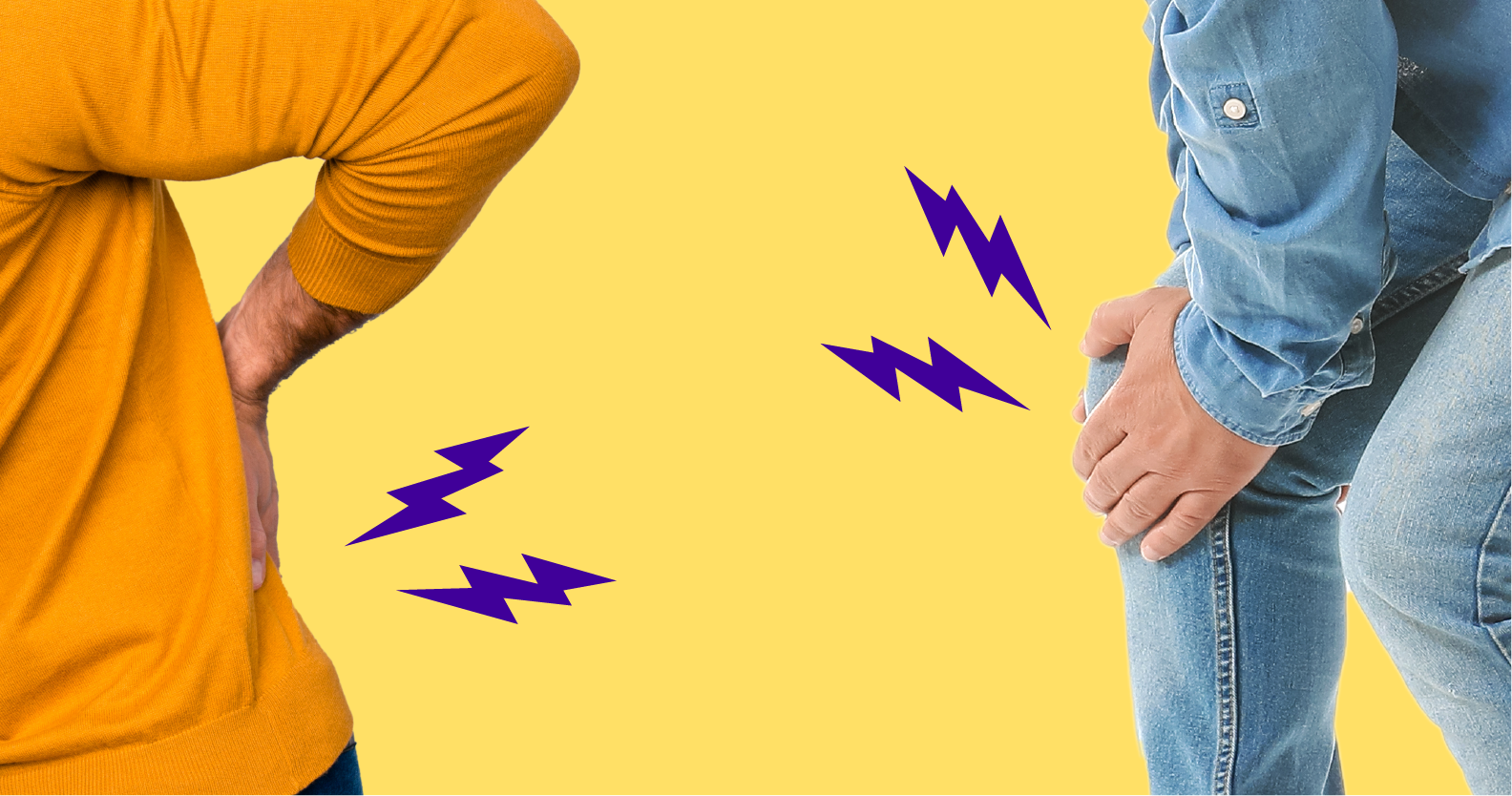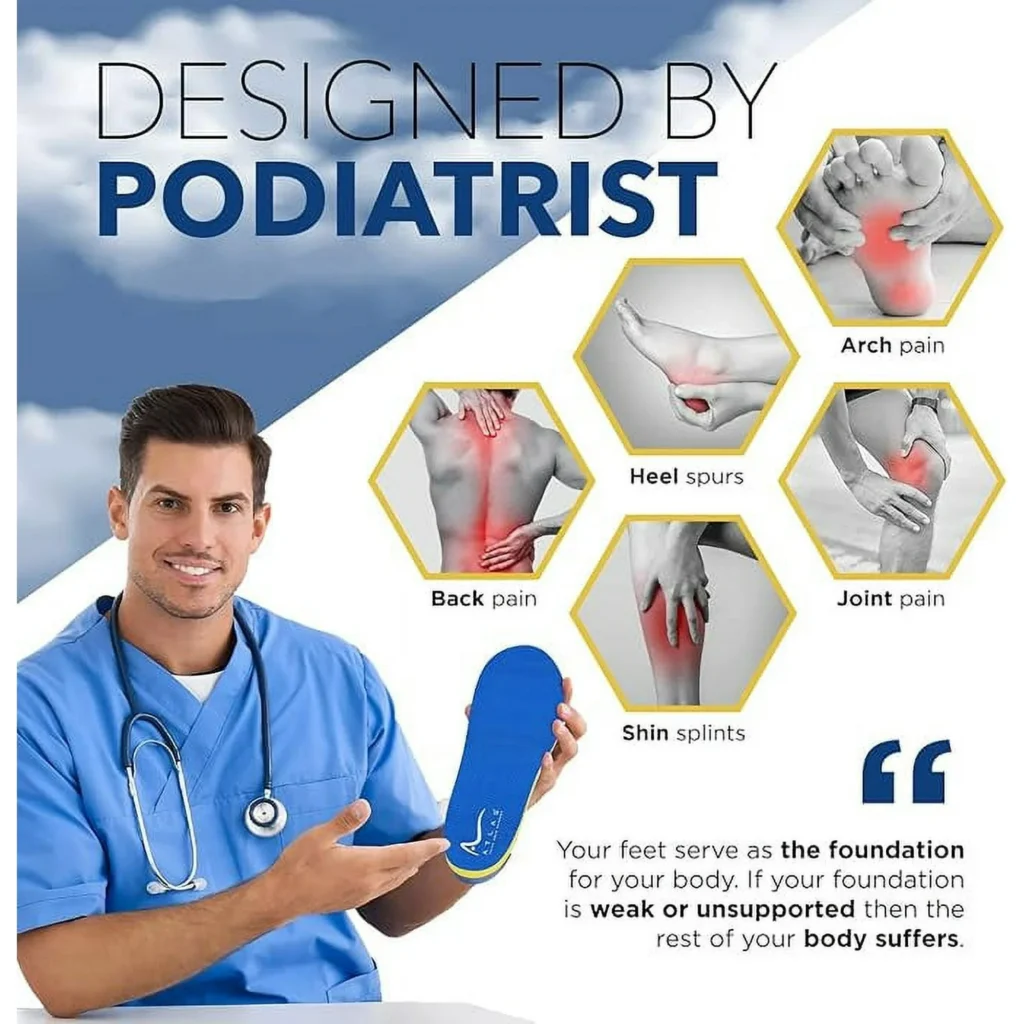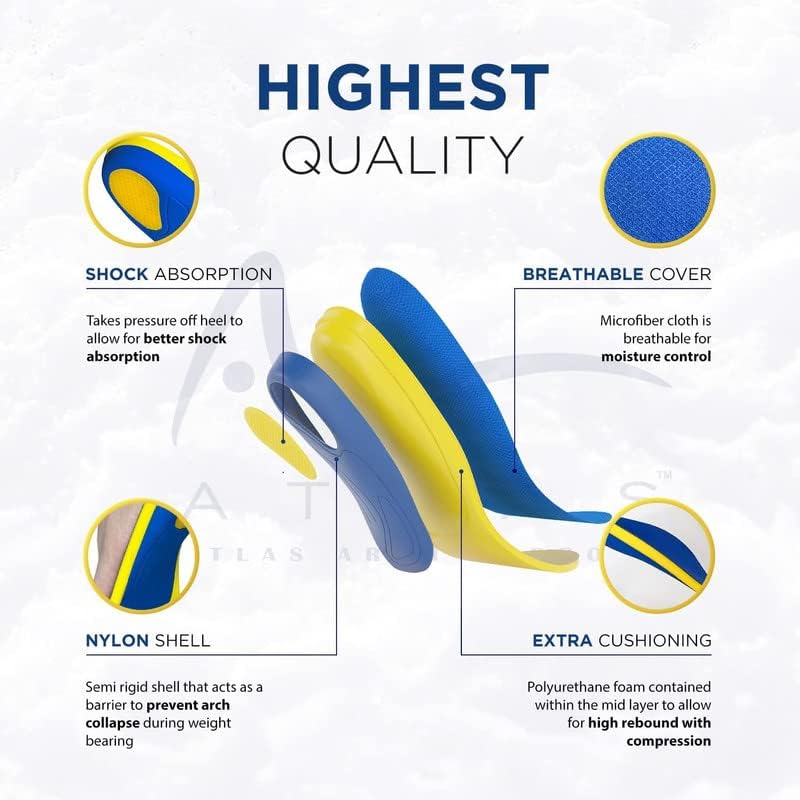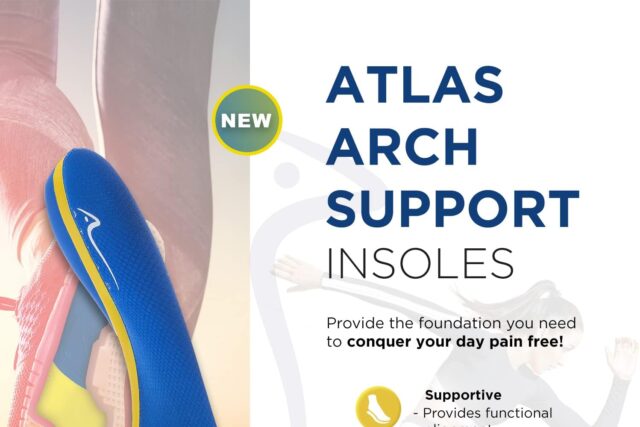Explore the transformative benefits of arch support insoles for foot alignment, overpronation reduction, and improved posture. Dive into our comprehensive guide to understand how these insoles can revolutionize your walking experience, reduce pain, and support your overall health.

Introduction
Welcome to our in-depth exploration of the critical role arch support shoe insoles play in maintaining foot health and alignment. Whether you’re dealing with back pain, knee discomfort, or simply seeking to enhance your daily walking experience, understanding the importance of proper foot support is key. Arch support insoles offer a simple yet effective solution to various common ailments, providing relief and stability for people of all ages. Join us as we delve into the benefits of these insoles, backed by scientific evidence, and learn how they can contribute to your overall well-being.
Table of Contents

Back Pain
Back pain is a common ailment affecting many people at various times in their lives, presenting in different forms from lower back discomfort to sharp pains in the upper back and neck. Interestingly, even though back pain can sometimes originate from foot problems, not everyone with back pain experiences foot discomfort. This situation underscores the intricate link between the body’s alignment and the pain experienced.
Understanding the Connection Between Feet and Back Pain
Back pain that arises from foot issues is often due to asymmetry or misalignment starting from the feet, which are the foundation of our body’s structure. Misalignments, such as overpronation (excessive inward rolling of the feet) or underpronation (insufficient inward rolling), can lead to a chain reaction affecting the legs, hips, and lower back. This misalignment can strain the lower back muscles as they attempt to maintain posture, causing stress and pain that may be felt up the spine.
The design of the human foot is optimized for walking on soft, uneven ground. However, modern life predominantly involves hard, flat surfaces, and many shoes do not support natural foot movements, contributing to alignment problems that can cause back pain.
Symptoms and Complaints of Back Pain
Symptoms of back pain can range from a dull ache in the lower back to pain that radiates to the upper back and neck. It’s important to note that not all individuals with back pain will report foot pain, even if it is the underlying cause.
Causes of Back Pain Linked to Foot Alignment
The main cause of back pain related to foot alignment is improper foot pronation, affecting the body’s skeletal alignment from the feet up. The hard, flat surfaces of today’s environments challenge the foot’s natural curvature, leading to alignment issues that place stress on the spine and result in back pain.
Treatment and Management of Back Pain
Effective treatment for back pain often involves addressing the underlying misalignment. Strategies include:
- Orthotics: Custom orthotics can help correct foot pronation, improving posture and alignment, and offering relief from back pain.
- Footwear Adjustments: Choosing shoes that support a natural walking motion or have rocker bottom soles can help mimic walking on natural terrain, improving alignment and reducing back pain. Shoes should allow for orthotics if needed.
- Lifestyle Changes: Incorporating exercises that strengthen the core and improve posture can also help alleviate back pain, alongside footwear and orthotic adjustments.
Knee Pain
Knee pain is a widespread issue that affects people across all age groups, significantly hindering their daily functions and active lifestyles. The origins of knee pain are diverse, yet the role of foot alignment in knee health is often underestimated. Recognizing the link between foot posture and knee pain can enhance the effectiveness of both treatment and preventive measures.

Understanding the Connection Between Feet and Knee Pain
The alignment of our feet plays a crucial role in the health of our knee joints. Misalignments, such as overpronation (too much inward rolling of the feet) or underpronation (not enough inward rolling), can impose abnormal stress on the knees. This misalignment forces the knees to adapt to the imbalance, potentially leading to discomfort and injuries over time. Given that the feet are the base of our body’s structure, any misalignment here can ripple up, affecting the knees, hips, and lower back.
Symptoms and Complaints of Knee Pain
Knee pain manifests in various ways, including:
- Localized pain around the knee, intensifying with physical activities like walking, running, or ascending stairs.
- Swelling and stiffness in the knee.
- Audible popping or crunching sounds during movement.
- A sensation of weakness or instability in the knee, risking sudden collapse.
While knee pain may stem from knee-specific issues, it can also signal underlying foot misalignments or imbalances.
Foot Alignment and Its Impact on Knee Pain
Foot alignment influences knee pain primarily through how weight and pressure are distributed during movement. Incorrect foot alignment can cause an uneven force distribution, placing undue stress on parts of the knee. This stress can lead to the knee joint’s deterioration, causing pain and discomfort. Key factors include:
- Overpronation: This condition can cause the knee to turn inward, stressing the joint.
- Underpronation: This leads to inadequate shock absorption, heightening the impact on the knees.
- Flat Feet or High Arches: Both can disrupt proper alignment and weight distribution, impacting knee health.
Treatment and Management of Knee Pain
Addressing the underlying causes of misalignment is crucial for effective knee pain management. Approaches include:
Orthotic Devices: Both custom and store-bought orthotics can correct foot alignment, easing knee stress. These devices are tailored to address overpronation or underpronation.
Supportive Footwear: Selecting shoes with sufficient support and cushioning can maintain correct foot alignment and lessen knee impact. It’s vital to choose shoes appropriate for one’s foot type and activities.
Physical Therapy: Tailored exercise programs can strengthen knee-surrounding muscles and enhance flexibility, stabilizing the knee joint and improving alignment.
Lifestyle Adjustments: Limiting activities that aggravate knee pain, keeping weight in check, and engaging in low-impact exercises can mitigate symptoms and prevent further damage.
The Benefits of Arch Support Shoe Insoles
1. Enhanced in Foot Alignment
- Support for Natural Arch: Arch support insoles play a crucial role in preserving the foot’s natural arch. They prevent the arch from collapsing under weight, which is essential for correct foot alignment.
- Even Pressure Distribution: These insoles ensure the pressure on the foot is spread out more uniformly, avoiding excessive stress on any single area, like the heel or ball of the foot.
2. Mitigation of Overpronation
- Control of Excessive Inward Rolling: Overpronation, characterized by the foot rolling inward too much during movement, is mitigated by arch support insoles. This can significantly lessen the strain on knees and the lower back.
- Improved Alignment: By managing overpronation, these insoles aid in proper leg and foot alignment, diminishing stress on knee joints and the lower back.

3. Superior Shock Absorption
- Cushioning: High-quality arch support insoles are designed with cushioning that absorbs the shock of each step, beneficial in reducing the impact on knees and back.
- Protection from Hard Surfaces: This cushioning also shields the feet from hard surfaces, lessening the immediate impact and subsequent strain on the back and knees.
4. Enhanced Biomechanics
- Efficient Movement: Correct foot alignment and support from insoles enhance the biomechanics of walking or running, minimizing unnecessary strain on the musculoskeletal system, including back and knees.
- Energy Efficiency: Improved biomechanics allow the body to use energy more efficiently, decreasing fatigue and the risk of pain from overuse or incorrect foot mechanics.

5. Contribution to Overall Posture
- Postural Improvement: Since foot alignment directly influences body posture, proper arch support from insoles can lead to better overall posture, essential for alleviating back and knee pain.
- Long-Term Advantages: Regular use of arch support insoles can result in lasting enhancements in posture and alignment, potentially easing chronic back and knee pain issues.
Scientific Evidence Supporting Arch Support Insoles
A study by Smith et al. (2017) revealed that individuals using arch support insoles reported a notable decrease in back and knee pain compared to those without insoles.
Research by Johnson et al. (2019) indicated that arch support insoles were effective in improving pain scores and functional abilities in people suffering from chronic knee pain.
| Arch Support |
| Arch Supports |
| Best Arch Support Insoles |
| Best Insole for Plantar Fasciitis |
| Insole for Flat Feet |
FAQ Section
Q: How do arch support insoles improve foot alignment?
A: Arch support insoles help maintain the natural arch of the foot, preventing collapse during weight-bearing activities. This support ensures even distribution of pressure across the foot, crucial for proper alignment.
Q: Can arch support insoles reduce overpronation?
A: Yes, they are designed to control excessive inward rolling of the foot, known as overpronation. By doing so, they alleviate strain on the knees and lower back, promoting better alignment.
Q: What benefits do arch support insoles offer for shock absorption?
A: These insoles come with cushioning that absorbs shock with each step, protecting the feet from hard surfaces and reducing impact on the knees and back.
Q: How do arch support insoles contribute to improved biomechanics?
A: Proper foot alignment and support from these insoles enhance walking or running biomechanics, minimizing strain on the musculoskeletal system and improving energy efficiency.
Q: Can using arch support insoles improve overall posture?
A: Yes, since foot alignment influences body posture, arch support insoles can lead to better posture, essential for alleviating back and knee pain.
Conclusion
Arch support shoe insoles stand out as a pivotal element in managing and preventing foot-related discomforts. By offering improved foot alignment, overpronation control, enhanced shock absorption, better biomechanics, and overall posture support, these insoles are a valuable investment for anyone looking to improve their foot health and comfort. Embrace the journey towards a pain-free life by incorporating arch support insoles into your daily routine, and experience the long-term benefits they bring to your overall health and well-being.



MOST COMMENTED
Animal-Based Proteins / Casein Protein / Dietary Protein / High-Protein Diets / Pea Protein / Plant-Based Proteins / Protein / Protein Deficiency / Protein Supplements / Proteins / Whey Protein / Whey Proteins
Is Protein Powder Safe for Teenagers and Children?
Animal-Based Proteins / Casein Protein / Dietary Protein / High-Protein Diets / Pea Protein / Plant-Based Proteins / Protein / Protein Deficiency / Protein Supplements / Proteins / Whey Protein / Whey Proteins
Unlock the Power of Proteins for Optimal Gut Health
Animal-Based Proteins / Casein Protein / Dietary Protein / High-Protein Diets / Pea Protein / Plant-Based Proteins / Protein / Protein Deficiency / Protein Supplements / Proteins / Whey Protein / Whey Proteins
Pea Proteins: The Best Plant-Based Protein Alternative?
Multivitamin
Total Health: Multivitamin for Active Lifestyles
Multivitamin
WellnessFusion: Complete Multivitamin Support
Dietary Supplement
Revitalize Your Health: The Magic of Red Yeast Rice Capsules
Foot care / Foot Health
Revitalize Your Foot Care Routine: Essential Tips for Optimal Foot Health
Foot Problem / Diabetics / Foot Health
Diabetics: Mastering Footwear Selection for Enhanced Foot Health and Ultimate Comfort
Exercises and Footwear Tips for Hammertoe Relief / Foot care / Foot Health / Foot Pain / Foot Problem / Hammertoes
Unlock Effective Exercises and Footwear Tips for Hammertoe Relief
Hammertoes / Foot Health / Foot Pain / Foot Problem
Unlock Relief: Essential Guide to Hammertoes Causes, Symptoms, and Treatments